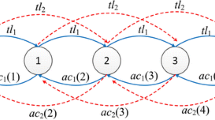Abstract
Cellular communicationnetworks satisfy the very conditions required to be complex adaptivesystems,so it is expected thatinteresting phenomenaproper to themcan be observed in their behaviors.In this paper,assuming three kinds of cellular networkssuch as CDMA, FCA-TDMA and DCA-TDMA networks,we examine their traffic intensity dynamicsby computer simulation.We show thatDCA-TDMA network has a hidden cause to producea long-range time dependence in its traffic intensity dynamics,so self-similarity appears there,regardless of property of traffic source andservice generation rate.Furthermore,we reveal that the cause is a strong interdependency amongcells through inter-cell interference.
Similar content being viewed by others
References
W.E. Leland, M.S. Taqqu, W. Willinger and D.V. Wilson, “On the Self-similar Nature of Ethernet Traffic (extended version)”, IEEE/ACM, Trans. on Networking, Vol. 2, No. 1, pp. 1–15, 1994.
V. Paxson and S. Floyd, “The Failure of Poisson Modeling”, in Proc. of SIGCOMM'94, 1994, pp. 257–268.
M. Jiang, M. Nikolic, S. Hardy and L. Trajkovic, “Impact of Self-similarity on Wireless Data Network Performance”, in Proc. IEEE ICC2001, Helsinki, Finland, June 11–14, 2001, pp. 477–481.
M.E. Crovella and A. Bestavros, “Self-similarity in World Wide Web Traffic: Evidence and Possible Causes”, IEEE/ACM Trans. Networking, Vol. 3, No. 6, pp. 835–846, 1997.
M.E. Crovella, M.S. Taqqu and A. Bestavros, “Heavy-tailed Probability Distributions in the World Wide Web”, A Practical Guide To Heavy Tails: Statistical Techniques for Analyzing Heavy Tailed Distributions, Birkhauser: Boston, 1998.
M. Takayasu, “Self-organizing Phenomenon in Internet Information Flow” (in Japanese), Mathematical Science, No. 427, pp. 64–74, 1999.
I. Katzela and M. Naghshineh, “Channel Allocation Schemes for Cellular Mobile Telecommunication Systems: A Comprehensive Survey”, IEEE Pers. Commun., Vol. 3, No. 3, pp. 10–31, 1996.
“Guidelines for Evaluation of Radio Transmission Technologies for IMT-2000/FPLMTS”, ITU-R Communication Study Group, June 1996.
J. Beran, Statistics for Long-memory Processes, Chapman and Hall/CRC, 1994.
M. Miyashita and S. Hara, “On the Self-similar Nature of Cellular System Traffic” (in Japanese), IEICE, Tech. Rep., SST99-40, pp. 1–6, Nov. 1999.
M. Miyashita and S. Hara, “On the Self-similar Nature of Cellular System Multimedia Traffic” (in Japanese), IEICE, Tech. Rep., SST99-102, pp. 41–46, Feb. 2000.
J. Taketsugu and S. Hara, “Traffic Self-similarity and Its Effect in Cellular System” (in Japanese), IEICE, Tech. Rep., RCS2000-260, pp. 99–104, Mar. 2001.
J. Taketsugu and S. Hara, “Traffic Self-similarity and Its Effect in Cellular System” (in Japanese), in Proc. 2001 IEICE Gene. Conf., B-5-112, Mar. 2001, p. 510.
J. Taketsugu and S. Hara, “Self-similarity in Cellular Network Traffic: Another Cause of Long-range Dependence”, in Proc. 4th WPMC, Aalborg, Denmark, Sept. 9–12, 2001, pp. 1579–1583.
Author information
Authors and Affiliations
Rights and permissions
About this article
Cite this article
Hara, S., Taketsugu, J. Another Cause of Long-Range Time Dependence. Wireless Personal Communications 23, 207–216 (2002). https://doi.org/10.1023/A:1020988904597
Issue Date:
DOI: https://doi.org/10.1023/A:1020988904597




